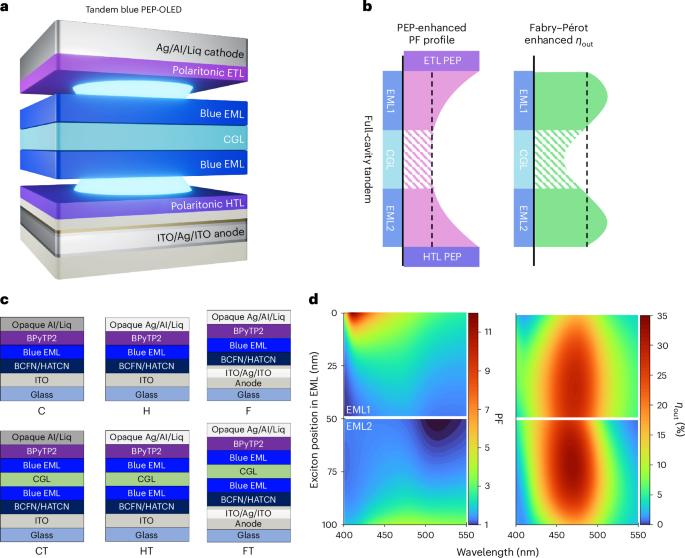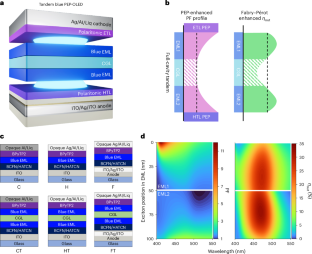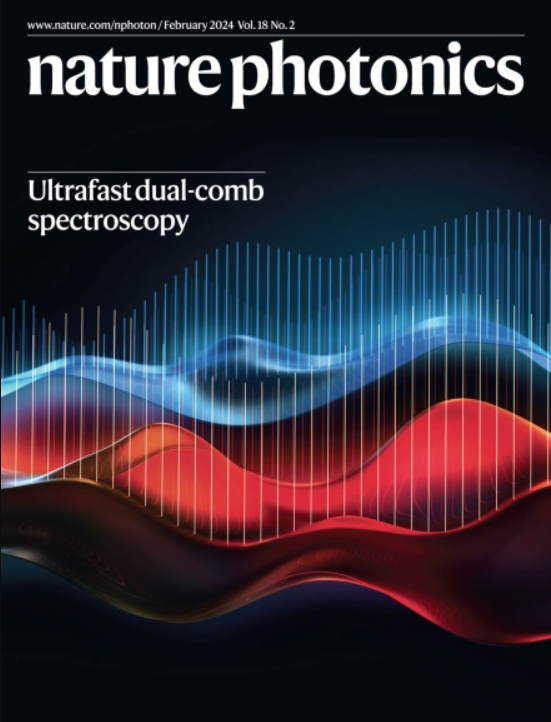Stable, deep blue tandem phosphorescent organic light-emitting diode enabled by the double-sided polariton-enhanced Purcell effect
IF 32.9
1区 物理与天体物理
Q1 OPTICS
引用次数: 0
Abstract
Blue phosphorescent organic light-emitting diodes (PHOLEDs) are highly efficient, although their short operational lifetimes have limited their commercial acceptance in displays and lighting. A high density of energetic triplet excitons accumulates in the emission layer that eventually annihilate, leading to molecular degradation. Here we report long operational lifetime, efficient and deep blue tandem PHOLEDs using the polariton-enhanced Purcell (PEP) effect at both the diode cathode and anode. The Pt- and Ir-complex-based bottom-emitting tandem PEP-PHOLEDs show a tenfold increase in lifetime and colour saturation compared with their analogous single-junction PHOLEDs. Particularly, the Pt-complex-based tandem PEP-PHOLED on flat glass substrates has lifetimes of LT90 = 830 ± 30 h and 1,800 ± 100 h (LT90 = the time to reach 90% of the initial luminance of 500 cd m−2), and forward-viewing external quantum efficiencies of 36.8 ± 0.5% or 56.0 ± 1.0% without or with substrate light extraction, respectively. The lifetime enhancement is equivalent to 250 times that of conventional single-junction Ir-based PHOLED lifetimes with similar blue chromaticity coordinates. The tandem PEP-PHOLED has chromaticity coordinates of CIExy = (0.14, 0.12) and a marginally perceptible colour shift with viewing angle up to ±75°. The double-sided PEP effect is readily integrated with other established lifetime-extending technologies, allowing for a multiplicative increase in lifetime. To our knowledge, this is the first demonstration of a deep blue PHOLED that shows stability comparable to green PHOLEDs, accelerating the use of the deep blue phosphorescent emitters in power-efficient displays and lighting. Exploiting the polariton-enhanced Purcell effect in tandem organic light-emitting diodes enables deep-blue-emitting devices with an external quantum efficiency of 36.8% and an LT90 lifetime of 830 h at an initial luminance of 500 cd m−2. These metrics are increased to 56% and 1,800 h with substrate light outcoupling.


稳定的深蓝色串联磷光有机发光二极管,双面极化增强珀塞尔效应
蓝色磷光有机发光二极管(PHOLEDs)是高效的,尽管它们的短工作寿命限制了它们在显示器和照明方面的商业接受度。高密度的高能三重态激子在发射层中积累,最终湮灭,导致分子降解。在这里,我们报道了在二极管阴极和阳极使用极化增强珀塞尔(PEP)效应的长工作寿命,高效和深蓝串联二极管。基于Pt和ir络合物的底发射串联pep - pholed与类似的单结pholed相比,其寿命和色彩饱和度增加了十倍。特别是,平板玻璃基板上基于pt配合物的串联PEP-PHOLED的寿命分别为LT90 = 830±30 h和1800±100 h (LT90 =达到500 cd m−2初始亮度90%的时间),前向外量子效率分别为36.8±0.5%和56.0±1.0%。在相似的蓝色色度坐标下,寿命延长相当于传统单结ir基PHOLED寿命的250倍。串联PEP-PHOLED的色度坐标为CIExy =(0.14, 0.12),在视角可达±75°的情况下,可轻微感知色移。双面PEP效果很容易与其他已建立的延长使用寿命的技术集成,从而使使用寿命成倍增加。据我们所知,这是深蓝色PHOLED的首次演示,显示出与绿色PHOLED相当的稳定性,加速了深蓝色磷光发射器在节能显示器和照明中的使用。
本文章由计算机程序翻译,如有差异,请以英文原文为准。
求助全文
约1分钟内获得全文
求助全文
来源期刊

Nature Photonics
物理-光学
CiteScore
54.20
自引率
1.70%
发文量
158
审稿时长
12 months
期刊介绍:
Nature Photonics is a monthly journal dedicated to the scientific study and application of light, known as Photonics. It publishes top-quality, peer-reviewed research across all areas of light generation, manipulation, and detection.
The journal encompasses research into the fundamental properties of light and its interactions with matter, as well as the latest developments in optoelectronic devices and emerging photonics applications. Topics covered include lasers, LEDs, imaging, detectors, optoelectronic devices, quantum optics, biophotonics, optical data storage, spectroscopy, fiber optics, solar energy, displays, terahertz technology, nonlinear optics, plasmonics, nanophotonics, and X-rays.
In addition to research papers and review articles summarizing scientific findings in optoelectronics, Nature Photonics also features News and Views pieces and research highlights. It uniquely includes articles on the business aspects of the industry, such as technology commercialization and market analysis, offering a comprehensive perspective on the field.
 求助内容:
求助内容: 应助结果提醒方式:
应助结果提醒方式:


